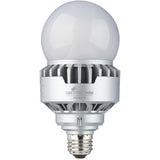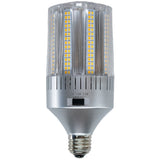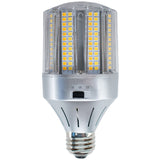LED Outdoor Area Light Fixtures Meet or Exceed Performance Metrics of HID Alternatives
Posted by Dave on for ProLampSales

A significant contributor to electrical energy use in the U.S. is outdoor area lighting. Street and roadway lights, walkway and park lighting, surface parking pole mounted fixtures and building mounted wall packs are all designed to illuminate space at night to provide safe passage and security for vehicles and pedestrians.
Some of the earliest dedicated LED lighting fixtures were for outdoor area lighting applications. By 2017, LED area lighting has matured to the point that according to a U.S. Department of Energy CALiPER report, "LED outdoor luminaries easily outclass their conventional counterparts such as fixtures using high pressure sodium lamps."
Dedicated LED area light fixtures offer equivalent light output to fixtures using HID light sources with over 60% less energy use. In addition, the color rendering of LED is generally superior to HID which improves visibility. At the same time, warmer color temperatures are available for applications were there is concern over glare and the negative effects of nighttime lighting.
The latest USDOE CALiPER Snapshot evaluates current outdoor area lighting products on the market for lumen output, color characteristics and efficacy. This post presents these findings.
Lumen Output
The range of lumen output for LED outdoor area lighting fixtures is extensive and is indicative of the large number of LED products in this category on the market. Common LED fixture outputs are designed to replace these high pressure sodium (HPS) wattage fixtures: 70W, 100W, 150W, 250W, 400W and 1,000W.
According to the USDOE, improved LED luminous intensity distributions allow less total lumen output compared to the HID to deliver the same illuminance.
Efficacy
The range of efficacy for LED outdoor area lighting luminaries follows the pattern of lumen output. At the low end efficacy starts at 70 lumens per watt (lm/W) and reaches as high as 150 lm/W. While the mean efficacy for outdoor area fixtures is slightly lower than common indoor fixtures such as troffers and linear lighting – about 100 lm/W for area lights compared to about 110 lm/W for troffers and linear fixtures this difference is not significant. It may be the result of outdoor area lights requiring more precise luminous intensity distributions and other factors unique to outdoor lighting.
In the last 12 months, the percentage of LED outdoor area luminaries meeting the DesignLights Consortium (DLC) Qualified Products list for lumen output and efficacy has increased from 49% to 63%. Similarly, the percentage of outdoor area luminaries meeting the DLC Premium requirements for the same metrics has increased from 10% to 25%. These improvements illustrate how rapidly manufactures are incorporating improved LED technology into their fixtures.
Color Quality
Most LED street and walkway area light fixtures have a color rendering index around 70. While this is low for most indoor lighting applications, it is higher than HPS light sources and equal to or higher than most metal halide.
Combined with a typical color temperature range of 4000K to 5000K, these color metrics mean that the majority of LED area light fixtures on the market meet the CRI and CCT requirements for DLC qualification.
Summary of Trends for Outdoor Area Lighting
- Efficacy: There has been an annual improvement of efficacy to the point where in 2017 mean efficacy ranges from 99 to 106 lm/W up to 150 lm/W.
- Lumen Output: Lumen levels in 2017 for most products are effectively equivalent to high-intensity discharge lamps.
- Color Characteristics: With a range of CCT and CRI values to choose from for the majority of LED area lighting fixtures, buyers can achieve color quality that is equal to or better than those for HID.
- Rated Life of the LED Array: between 75,000 and 130,000 hours
According to the 2017 DOE CALiPER report, LED area / roadway luminaries have achieved a 28% market penetration in the U.S. Only small directional LED fixtures have a higher penetration at this time.
Lower pricing and reduced maintenance costs combined with the fact that key performance metrics meet or exceed the HID alternatives put LED area lighting in a very strong competitive position for specifiers and buyers.
Featured Products (View All)
- 0 Comments
- Posted in Fixtures, Landscape & Outdoor, LED
0 Comments




